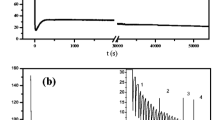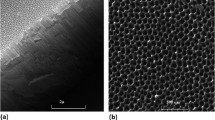Abstract
Ordered 30-nm Co1−xSnx (0 ≤ x ≤ 0.78) nanowire arrays have been prepared by co-electrodeposition of Co and Sn into pores of homemade anodized aluminum oxide (AAO). The magnetic properties of the Co1−xSnx nanowires are presented as a function of Sn content (x), annealing, electrolyte pH, electrodeposition frequency, and wave form. The result of energy-dispersive x-ray spectroscopy (EDX) showed anomalous co-deposition for Co and Sn. The nanowires have uniaxial magnetic anisotropy with easy magnetization direction along the nanowire axis due to the large shape anisotropy. As-deposited and annealed alloy nanowires, determined by x-ray diffraction (XRD), have amorphous phase. The nanowires electrodeposited at different pH and the electrodeposition frequencies have significantly different magnetic properties. Magnetization measurement showed that variation in magnetic properties of the nanowire arrays rooted in surface formation of Co(OH)2 and Sn(OH)2 in upper pH. The XRD patterns of Co and Co0.97Sn0.03 of nanowires obtained at pH = 2 and 4 obviously illustrated that pH affects the crystal structure of Co nanowires but has no effect on alloy nanowires. Moreover, the precipitation process was affected by raising the electrodepositing frequency via changing the rate of reduction of solute ions. The electrodeposition wave form has no significant effect on nanowire magnetic properties. The considerable enhanced coercivity has been measured in annealed nanowires. Experimental data demonstrate that the optimized composition for annealed Co1−xSnx nanowire is around Co0.93Sn0.07 in which the coercivity (Hc) has a maximum value of 2030 Oe.












Similar content being viewed by others
References
S-C. Lin, S-Y. Chen, Y-T. Chen, and S-Y. Cheng: Electrochemical fabrication and magnetic properties of highly ordered silver–nickel core-shell nanowires. J. Alloys Compd. 449, 232 (2008).
M. Shima, M. Hwang, and C.A. Ross: Magnetic behavior of amorphous CoP cylinder arrays. J. Appl. Phys. 93, 3440 (2003).
G.B. Ji, W. Chen, S.L. Tang, B.X. Gu, Z. Li, and Y.W. Du: Fabrication and magnetic properties of ordered 20 nm Co–Pb nanowire arrays. Solid State Commun. 130, 541 (2004).
S.C. Kung, W. Xing, K.C. Donavan, F. Yang, and R.M. Penner: Photolithographically patterned silver nanowire electrodeposition. Electrochim. Acta 55, 8074 (2010).
O. Lupan, V.V. Ursaki, G. Chai, L. Chow, G.A. Emelchenko, I.M. Tiginyanu, A.N. Gruzintsev, and A.N. Redkin: Selective hydrogen gas nanosensor using individual ZnO nanowire with fast response at room temperature. Sens. Actuators, B 144, 56–66 (2010).
S. Sen, P. Kanitkar, A. Sharma, K.P. Muthe, A. Rath, S.K. Deshpande, M. Kaur, R.C. Aiyer, S.K. Gupta, and J.V. Yakhmi: Growth of SnO2/W18O49 nanowire hierarchical heterostructure and their application as chemical sensor. Sens. Actuators, B 147, 453 (2010).
O. Jessensky, F. Müller, and U. Gösele: Self-organized formation of hexagonal pore arrays in anodic alumina. Appl. Phys. Lett. 72, 1173 (1998).
Y. Xu, D.S. Xue, D.Q. Gao, J.L. Fu, X.L. Fan, D.W. Guo, B. Gao, and W.B. Sui: Ordered CoFe2O4 nanowire arrays with preferred crystal orientation and magnetic anisotropy. Electrochim. Acta 54, 5684 (2009).
A. Jagminas, K. Maţeika, E. Juška, J. Reklaitis, and D. Baltrūnas: Electrochemical fabrication and characterization of lepidocrocite (γ-FeOOH) nanowire arrays. Appl. Surf. Sci. 256, 3993 (2010).
Y. Li, Y. Huang, L. Yan, S. Qi, L. Miao, Y. Wang, and Q. Wang: Synthesis and magnetic properties of ordered barium ferrite nanowire arrays in AAO template. Appl. Surf. Sci. 257, 8974–8980 (2011).
M. Almasi Kashi, A. Ramazani, F. Adelnia Najafabadi, and Z. Heydari: Controlled Cu content of electrodeposited CoCu nanowires through pulse features and investigations of microstructures and magnetic properties. Appl. Surf. Sci. 257, 9347 (2011).
R.L. Wang, S.L. Tang, Y.G. Shi, X.L. Fei, B. Nie, and Y.W. Du: Effects of annealing on the structure and magnetic properties of Fe27Co23Pb50 nanowire arrays. J. Appl. Phys. 103, 07D507 (2008).
J.P. Xu, Z.Z. Zhang, B. Ma, and Q.Y. Jin: Compositional control of FexPt(1−x) nanowires by electrodeposition. J. Appl. Phys. 109, 07B704 (2011).
K.R. Pirota, F. Béron, D. Zanchet, T.C.R. Rocha, D. Navas, J. Torrejón, M. Vazquez, and M. Knobel: Magnetic and structural properties of fcc/hcp bi-crystalline multilayer Co nanowire arrays prepared by controlled electroplating. J. Appl. Phys. 109, 083919 (2011).
L.G. Vivas, M. Vázquez, V. Vega, J. García, W.O. Rosa, R.P. del Real, and V.M. Prida: Temperature dependent magnetization in Co-base nanowire arrays: Role of crystalline anisotropy. J. Appl. Phys. 111, 07A325 (2012).
G. Kartopu, O. Yalçın, M. Es-Souni, and A.C. Başaran: Magnetization behavior of ordered and high density Co nanowire arrays with varying aspect ratio. J. Appl. Phys. 103, 093915 (2008).
J. Zhang, G.A. Jones, T.H. Shen, S.E. Donnelly, and G.H. Li: Monocrystalline hexagonal-close-packed and polycrystalline face-centered-cubic Co nanowire arrays fabricated by pulse dc electrodeposition. J. Appl. Phys. 101, 054310 (2007).
X. Xu and G. Zangari: Microscopic structure and magnetic behavior of arrays of electrodeposited Ni and Fe nanowires. J. Appl. Phys. 97, 10A306 (2005).
A.S. Esmaeily, M. Venkatesan, A.S. Razavian, and J.M.D. Coey: Diameter-modulated ferromagnetic CoFe nanowires. J. Appl. Phys. 113, 17A327 (2013).
M.S. Sultan, B. Das, K. Mandal, and D. Atkinson: Magnetic field alignment of template released ferromagnetic nanowires. J. Appl. Phys. 112, 013910 (2012).
Q.F. Liu, J.B. Wang, Z.J. Yan, and D.S. Xue: The effect of diameter on micromagnetic properties of Fe0.68Ni0.32 nanowire arrays. J. Magn. Magn. Mater. 278, 323 (2004).
A. Saedi and M. Ghorbani: Electrodeposition of Ni–Fe–Co alloy nanowire in modified AAO template. Mater. Chem. Phys. 91, 417 (2005).
Y.W. Wang, L.D. Zhang, G.W. Meng, X.S. Peng, Y.X. Jin, and J. Zhang: Fabrication and the annealing temperature dependence of magnetic properties for ordered ferromagnetic-nonmagnetic alloy nanowire arrays. J. Phys. Chem. B 106, 2502 (2002).
G.B. Ji, S.L. Tang, B.X. Gu, and Y.W. Du: Ordered Co48Pb52 nanowire arrays electrodeposited in the porous anodic alumina oxide template with enhanced coercivity. J. Phys. Chem. B 108, 8862 (2004).
J.H. Min, J.H. Wu, J.U. Cho, J.H. Lee, Y.D. Ko, H.L. Liu, J.S. Chung, and Y.K. Kim: Electrochemical preparation of Co3Pt nanowires. Phys. Status Solidi A 204, 4158 (2007).
G. Mo, W. Cheng, Q. Cai, W. Wang, K. Zhang, X. Xing, Z. Chen, and Z. Wu: Structural change of Ni–Cu alloy nanowires with temperature studied by in situ X-ray absorption fine structure technique. Mater. Chem. Phys. 121, 390 (2010).
L. Liu, H. Li, S. Fan, J. Gu, Y. Li, and H. Sun: Fabrication and magnetic properties of Ni–Zn nanowire arrays. J. Magn. Magn. Mater. 321, 3511 (2009).
R.L. Wang, S.L. Tang, B. Nie, X.L. Fei, Y.G. Shi, and Y.W. Du: Fabrication and magnetic properties of ordered Fe60Pb40 nanowire arrays electrodeposited in AAO templates. Solid State Commun. 142, 639 (2007).
F. Li and L. Ren: Fabrication and magnetic properties of FePt3 nanowire arrays. Phys. Status Solidi A 193, 196 (2002).
M. Koohbor, S. Soltanian, M. Najafi, and P. Servati: Fabrication of CoZn alloy nanowire arrays: Significant improvement in magnetic properties by annealing process. Mater. Chem. Phys. 131, 728 (2012).
T. Wang, F. Li, Y. Wang, and L. Song: Structure and magnetic properties of metastable Co–Cu solid solution nanowire arrays fabricated by electrodeposition. Phys. Status Solidi A 203, 2426 (2006).
H. Masuda and K. Fukuda: Ordered metal nanohole arrays made by a two-step replication of honeycomb structure of anodic alumina. Science 268, 1466 (1995).
H. Masuda, F. Hasegawa, and S. Ono: Self ordering of cell arrangement of anodic porous alumina formed in sulfuric acid solution. J. Electrochem. Soc. 144, L127 (1997).
H. Masuda, K. Yada, and A. Osaka: Self-ordering of cell configuration of anodic porous alumina with large-size pores in phosphoric acid solution. Jpn. J. Appl. Phys. 37, L1340 (1998).
J.P. O’Sullivan and G.C. Wood: The morphology and mechanism of formation of porous anodic films on aluminium. Proc. R. Soc. London, Ser. A 317, 511 (1970).
M. Najafi, S. Soltanian, H. Danyali, R. Hallaj, A. Salimi, S.M. Elahi, and P. Servati: Preparation of cobalt nanowires in porous aluminum oxide: Study of the effect of barrier layer. J. Mater. Res. 27(18), 2382 (2012).
Acknowledgment
The authors are grateful for the financial support from the Grant Research Councils of Bu-Ali Sina University as well as HUT.
Author information
Authors and Affiliations
Corresponding author
Rights and permissions
About this article
Cite this article
Najafi, M., Rafati, A.A., Fart, M.K. et al. Effect of the pH and electrodeposition frequency on magnetic properties of binary Co1−xSnx nanowire arrays. Journal of Materials Research 29, 190–196 (2014). https://doi.org/10.1557/jmr.2013.371
Received:
Accepted:
Published:
Issue Date:
DOI: https://doi.org/10.1557/jmr.2013.371




